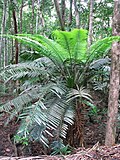| Lepidozamia | |
|---|---|
 | |
| Lepidozamia peroffskyana | |
| Scientific classification | |
| Kingdom: | Plantae |
| Clade: | Tracheophytes |
| Clade: | Gymnospermae |
| Division: | Cycadophyta |
| Class: | Cycadopsida |
| Order: | Cycadales |
| Family: | Zamiaceae |
| Subfamily: | Encephalartoideae |
| Tribe: | Encephalarteae |
| Subtribe: | Macrozamiinae |
| Genus: | Lepidozamia Regel [1] |
| Type species | |
| Lepidozamia peroffskyana Regel | |
| Synonyms | |
| |
Lepidozamia is a genus of two species of cycad, both endemic to Australia. [1] They are native to rainforest climates in eastern Queensland and eastern New South Wales. They have a diploid chromosome number of 2n = 18.








